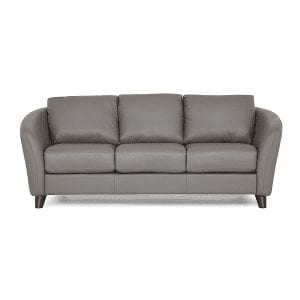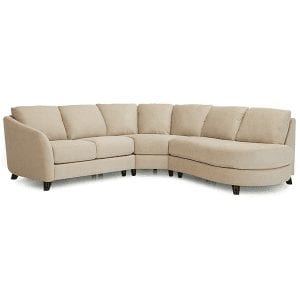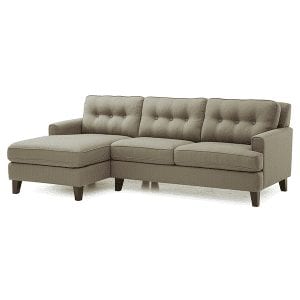A brand–new sofa or couch is a great investment that instantly updates your home decor.
One of the biggest decisions when making your purchase is whether to choose leather or fabric upholstery.
As with all furniture shopping, there are many criteria to consider. Think about whether you prefer a modern living room or a classic look. You’ll want to feel the upholstery to determine whether it is appealing to the touch. Consider how different colors will look in bright or dim lighting conditions.
Research the care requirements for different materials: How easy is it to clean up spills? How often do you need to clean? Finally, decide ahead of time how much you’d like to spend on your new furniture to narrow down your choices.
At Lifestyles Furniture, we offer a variety of beautiful sofas in a range of styles from traditional to contemporary. On top of that, most items in our showroom are customizable with your choice of upholstery. Here are some of the pros and cons of leather and fabric materials that you’ll want to keep in mind.
Leather Sofas
Nothing enhances your living room quite like the classic beauty of a leather sofa. Different types of leather include full-grain, top grain, bi-cast, suede and aniline.
Pros of a Leather Sofa
Elegant appearance: Leather upholstery is renowned for its elegant, sleek appearance that fits right in with a modern or mid-century decor. The classic Chesterfield style is a perennial favorite with its luxurious rolled arms that match the height of the back.
Another unique feature of leather is its natural sheen which may develop a patina over time. You may notice wrinkles or marbling which give the piece a sense of character as it ages.
Hypoallergenic: If you or a family member have trouble with respiratory allergies, a leather sofa is an excellent choice. Leather is less likely to harbor dust, dander and dust mites than most fabrics.
Easy to clean: A quality leather sofa can last for decades with minimal upkeep. The tanning process gives leather its well-known durability. It is a stain-resistant material that repels food and beverage spills with ease. For best results, lightly dust or rub on a regular basis. You can also prevent cracks or splits by occasionally conditioning the leather.
Cons of a Leather Sofa
Fewer options: Although you can find quality leather sofas in a range of colors and styles, the options are not quite as broad as with fabric upholstery. Leather sofas tend to look best when the rest of the living room decor is designed around them.
Scratches: Leather is vulnerable to visible scratches from pet claws, fingernails, scissors and other sharp objects. This makes it less than ideal for homes with kids and pets. In addition, light colored leather tends to show stains more easily. One option is to protect your investment with a slipcover in a durable fabric.
Temperature: Leather is known for heat and cold retention. This means it will feel cold to the touch during the winter and warm and “sticky” during the summer. In addition, many types of leather have a firmer texture than fabric, which may feel less comfortable than a soft fabric.
Cost: Leather has a higher unit cost than even most luxury fabrics. This means a leather sofa will typically cost you more than a comparable fabric sofa of the same style and size. One advantage to this is that high-quality leather often lasts longer than a less durable material.
Fabric Sofas
You can find quality sofas available in a wide variety of natural, synthetic and blended fabrics. Popular natural fabrics include wool, silk, linen and cotton. Synthetic fibers can be made from nylon, acylic, polypropylene or petroleum. Natural-synthetic blends are a great choice for beauty and durability.
Pros of a Fabric Sofa
Lots of Variety: Upholstery fabrics come in a vast array of colors, patterns and textures. This makes fabric sofas highly customizable and easier to match with your existing decor. Choose a brightly colored piece to grab attention, or go with a calming neutral to blend in seamlessly.
Comfort: Fabric tends to be more soft and pliable than leather. This makes it more cozy for watching a movie or curling up for a power nap. Look for a sofa with a sturdy frame and quality cushions to guard against wrinkling and sagging.
Low maintenance: A durable, stain-resistant fabric is made to look beautiful and withstand rigors of daily life. That’ll make it easy to clean up spills and stand up to your furry friends’ paws.
Affordability: As noted above, a quality fabric sofa usually costs less than a comparable leather sofa. That makes it easier to find a fabulous piece at a price to fit any budget.
Cons of a Fabric Sofa
Allergens: Fabrics tend to accumulate dust, dust mites, mold and pet dander, which may be a concern for people with allergies. The best solution is to vacuum fabric upholstery regularly to maintain good indoor air quality.
Care Requirements: Untreated fabrics tend to absorb liquids, which makes them more vulnerable to staining than leather. Look for a stain-resistant fabric that lets liquid bead on top of the surface instead of absorbing.
Wear and tear: Some delicate fabrics like velvet or linen may tear easily. You may also notice pilling and thinning of the material over time. To avoid this problem, choose a high-quality fabric that resists wear and tear for years of beautiful use.
If a new sofa is on your shopping list, come visit Lifestyles Furniture. Our design experts will help you choose the perfect model for your home, and we’ll let you customize it to fit your needs and your lifestyle.
You can also give us a call at 573-874-1550 or contact us online at any time!



